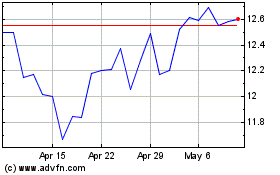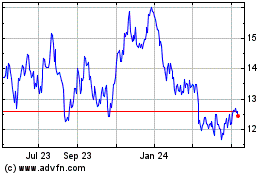By Paul Kiernan
RIO DE JANEIRO -- A catastrophic dam failure that killed 19
people and polluted hundreds of miles of rivers in Brazil last year
was the result of a mining company's repeated decision to
prioritize production over safety, Brazil's Federal Police said
Thursday.
Top executives at Samarco Mineração, the joint venture between
global mining giants Vale SA and BHP Billiton Ltd., for years were
aware of cracks and drainage problems at the Fundão tailings dam
that collapsed Nov. 5, the police said.
"Don't call it an accident," said Roger Lima de Moura, head of
the Federal Police task force that investigated the disaster,
calling the companies "more than negligent."
The risk was so high that company officials discussed purchasing
and relocating the village of Bento Rodrigues, which was wiped out
by a tsunami of mine waste after the dam broke, the authorities
said. But rather than taking precautionary measures like halting
production to reinforce Fundão, the company cut spending and
proceeded with a plan to increase output by 37%, the Federal Police
said.
Brazil's police presented the results of a seven-month
investigation that included phone calls and text messages among
Samarco executives, expert analysis and witness testimony. They
requested formal charges against eight company officials, including
former Chief Executive Ricardo Vescovi and a manager at Vale's
nearby Alegria mine, for environmental crimes.
Mr. Vescovi didn't immediately return emailed requests for
comment. Samarco said it "repudiates any speculation about previous
knowledge that the Fundão dam was in the imminent risk of
breaking."
Criminal proceedings against Samarco were suspended for more
than two months before a high court determined in late May that the
case would be heard at the federal level. The accusations unveiled
Thursday are part of a probe into environmental crimes by Samarco.
Federal prosecutors are carrying out a separate investigation into
the human toll after police recommended charges of " qualified
homicide" for the 19 deaths.
A separate civil case filed by federal prosecutors last month
called for 155 billion Brazilian reais ($45.6 billion) in damages,
comparing the fallout from Samarco's disaster to BP's Deepwater
Horizon 2010 oil spill in the Gulf of Mexico.
"BHP Billiton, Samarco and Vale have commissioned an external
study, led by global experts, into the technical causes of the
damage failure," a BHP spokesman said in an emailed statement
Thursday. "The panels finding on these issues will be made public
once they are complete."
The company declined to comment further.
Also accused of wrongdoing was a manager at Vale's nearby
Alegria mining complex which, investigators discovered after the
incident, had been dumping its own waste into Fundão with little
supervision, Mr. Moura said.
Vale said Thursday that it "repudiates, with vehemence," the
accusation against its employee, "who never had any responsibility
for management at the Fundão dam."
Mr. Moura said experts have confirmed the dam collapsed via
liquefaction, which occurs when water infiltrates an earthen
structure to the point that it can turn to mush.
Two things allowed water to infiltrate Fundão, the probe
alleges.
First, Mr. Moura said, Samarco skimped on drainage materials
when it built the base of the dam. The construction firm that did
the work testified that the Samarco chose to use mine detritus --
which it had in abundance -- rather than rock and gravel, as the
dam's design called for.
Second, Samarco allegedly departed from the blueprint of
Fundão's original designer, prominent Brazilian engineer Joaquim
Pimenta de Ávila.
Mr. Pimenta de Ávila designed Fundão's outer wall to run
straight across a gully. But around the time Mr. Pimenta de Ávila's
contract expired in 2012, Samarco started placing new levels of the
dam along an inward curve, satellite images show.
Mr. Moura said that below these new levels of the dam were
layers of mud-like mine detritus called "slimes." Engineers say
slime layers don't drain nearly as well as coarser materials and
that dams like Fundão should always be built upon sandy foundations
to ensure they stay dry.
The material Vale had been dumping into the dam was slimes, Mr.
Moura said.
Emails and phone records secured by police indicated Samarco's
top brass was aware of Fundão's problems, with Mr. Vescovi often
asking subordinates about specific issues, such as cracks in the
dam.
Mr. Pimenta de Ávila, who hasn't been accused of wrongdoing,
said in an interview earlier this year that he alerted Samarco to
"severe" structural problems at Fundão as recently as 2014.
But major interventions would have required Samarco to spend
more money on waste disposal or reduce production at its nearby
iron-ore mines, Mr. Moura said. Instead, the company's geotechnical
department -- responsible for dams -- cut spending from 25 million
reais in 2012 to 18 million reais last year.
Samarco's expansion plan was budgeted at $3 billion in 2011.
"The dam was a sick dam, that always had problems, kept having
to be fixed," Mr. Moura said. "So despite being aware of all those
problems that happened year in and year out...[Samarco] increased
production."
As Samarco ramped up output, Mr. Moura said, it was forced to
raise the height of Fundão faster than originally planned to store
all the waste being produced. In its final two years in operation,
the dam was raised 15 meters a year, while Mr. Pimenta de Ávila's
operation manual called for a maximum of six meters a year, he
said.
Engineers say rate of rise is a key factor in the safety of
earthen dams like Samarco's; if the structures are raised too
quickly, they may not have time to consolidate and stand a greater
risk of collapsing.
Samarco said the indentation in the dam and its rate of rise
"followed the premises and requirements found in the dam-operation
manual elaborated by its designer."
"Samarco always operated with high safety standards in all of
its processes and maintains all of its monitoring in line with the
legal requirements and best practices of the international mining
market," the company said.
Believed to be the global mining industry's biggest tailings-dam
failure, Fundão triggered what prosecutors say is Brazil's worst
environmental disaster ever. In addition to the workers and local
residents killed, hundreds of people in communities below the dam
were displaced.
Write to Paul Kiernan at paul.kiernan@wsj.com
(END) Dow Jones Newswires
June 10, 2016 02:49 ET (06:49 GMT)
Copyright (c) 2016 Dow Jones & Company, Inc.
Vale (NYSE:VALE)
Historical Stock Chart
From Mar 2024 to Apr 2024

Vale (NYSE:VALE)
Historical Stock Chart
From Apr 2023 to Apr 2024
